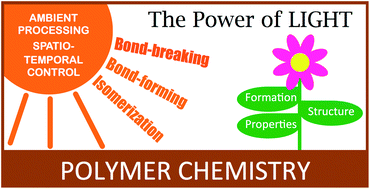The power of light in polymer science: photochemical processes to manipulate polymer formation, structure, and properties
Abstract
As the demand for polymeric materials transitions towards the need for customizable, high value, specialty polymeric materials, the ability to use light to initiate various physicochemical changes in polymers represents one of the most powerful and rapidly evolving approaches. Whether for polymer formation, polymer modification, shape change, or inducing smart material responses, light has the unique capacity for enabling 4D manipulation of each of those processes. Given the simple, 3D ability to focus light on a targeted voxel and the even simpler ability to turn a light on and off to facilitate temporal control, light has been used widely in various polymer modifications. Further, in addition to the ability to enhance the control of various reactive processes, due to the much greater energy available in a photon as compared to the thermal energy available, light enables chemical processes to occur at ambient conditions that are otherwise inaccessible without heating. In particular, within the polymer chemistry field, light has been used to cause bond formation, bond degradation, and isomerization, with subsequent reactions including polymerization, polymer degradation, polymer functionalization, and responsive changes in properties of smart materials. Here, this article attempts to provide a fundamental basis for the various photochemical processes implemented in polymer systems, followed by selected examples of that implementation in various polymerization, functionalization, degradation, and other reactions.

- This article is part of the themed collection: Polymer Chemistry 15th anniversary regional spotlight collection: The Americas

 Please wait while we load your content...
Please wait while we load your content...